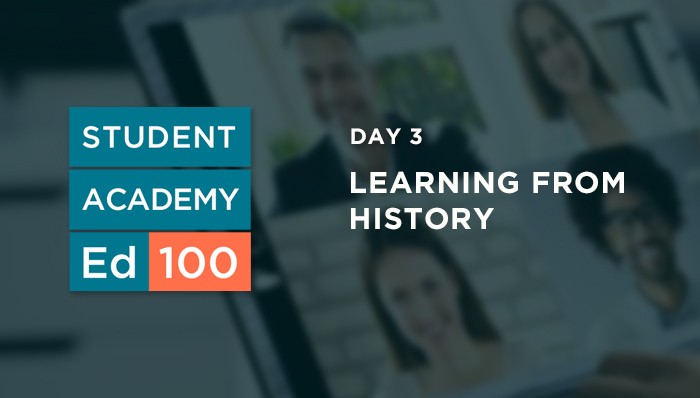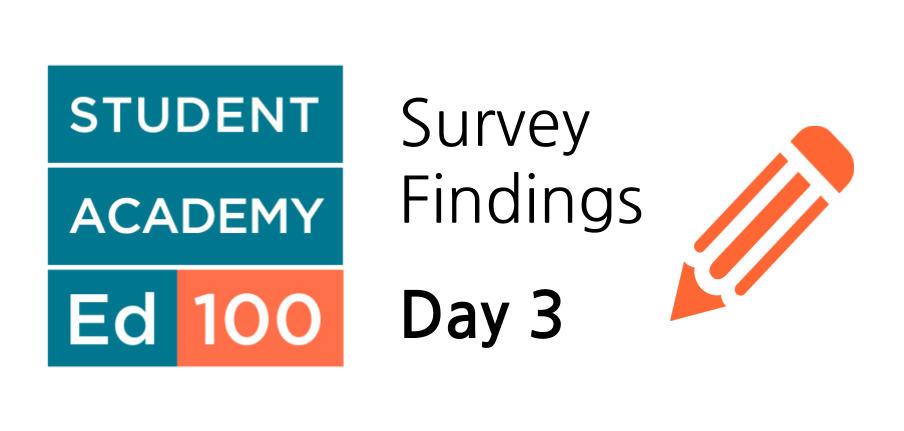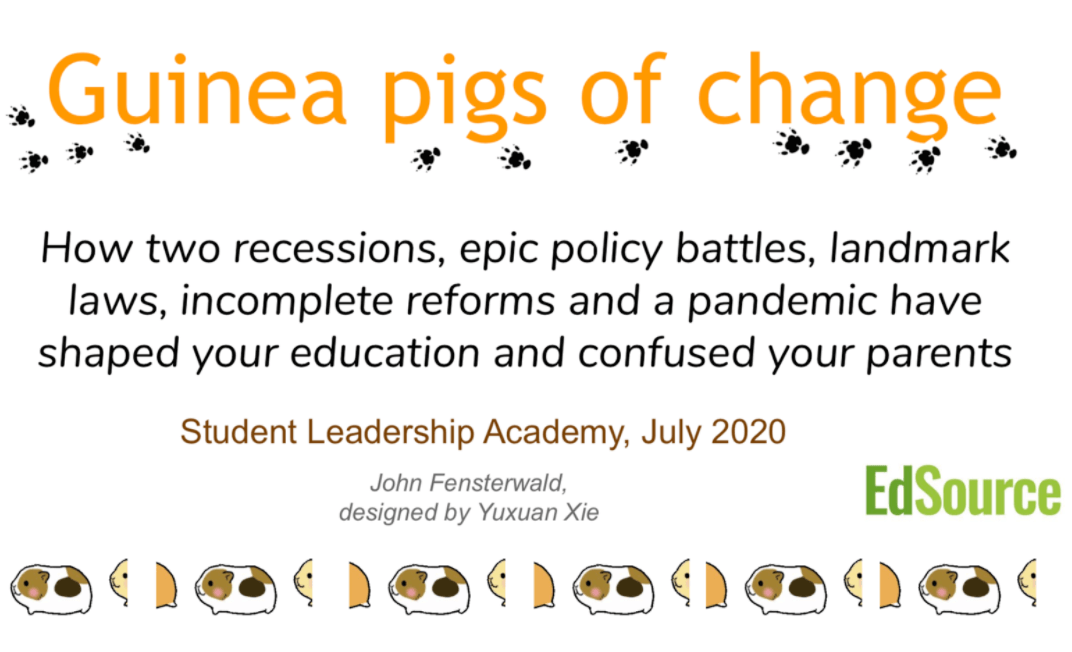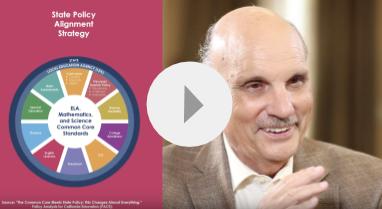The Ed100 Academy Day 3: Think Big and Learn from History

Thinking Bigger and Learning from History
This post continues our coverage of the 2020 Ed100 Academy for California Student Leaders. Our previous post in this series described the second day of the conference, in which students were introduced to six exceptional student leadership organizations and equipped with tools to help them succeed as student leaders. The theme was Developing Informed Leaders.
On Day 3, the theme was Thinking Bigger, which requires some understanding of how change has happened in the past. After exposure to the basics of California education on the first day and ways to get involved and make change on the second day, Day 3 focused on helping students consider their options for making their own impact.
|
|
10am - noon |
2pm - 4pm |
|---|---|---|
|
July 20 Monday |
① California's system |
② Equity in Education |
|
July 21 Tuesday |
③ Student Leadership |
④ Tools for Informed Leaders |
|
July 22 Wednesday |
⑤ Thinking Bigger |
⑥ Learning from History |
|
July 23 Thursday |
⑦ Working Together |
|
The Morning Session: Thinking Bigger

Each day of the conference we conducted a survey that included at least one major open-ended question: What are the three most important things you learned from today's sessions? If you want to get a feel for the robustness of the conference, browse through the responses.
Three things I learned: What are the three most important things you learned from today's sessions? See 172 responses
Our host, Brenna Pangelinan, opened the day with a recap video from Day 2 (see above). She also congratulated 21 students at the conference who had already become Ed100 graduates by passing every quiz offered.
Ted Dintersmith, Change Maker
The first speaker of the day was Ted Dintersmith, an education advocate, author, and filmmaker. In post-conference surveys, many students mentioned this presentation as one of the most valuable sessions.
Dintersmith challenged students to think for themselves about what makes a school successful. He pushed participants to think about the purpose of school and how their school could work better. Change doesn’t happen when students are complacent about their education. Student leaders, he argued, need to be advocates for change, not just passengers.
Be bold and audacious. The younger you are, the bolder you can be
Ted talked to student leaders about how today’s schools tend to reward students who have high memory retrieval, replicate low level procedures, and follow the rules. Schools adhere to a system that is simple and effective in teaching students to pass tests, he argued, but so what? “Education is designed as a compliance workplace. It’s not designed to be creative and bold.” Students should be taught innovation, entrepreneurship, and how to think critically and develop their own thoughts. Current students have a responsibility to advocate for the education they deserve, which includes teaching students to be educated thinkers and change-makers.
Before the conference, we encouraged participants to watch Ted’s award-winning film, “Most Likely to Succeed”, which points out the many ways the world has changed, but that most schools have not. Student leaders were provided a private Vimeo link to stream it for free.
Shereen Walter, California State PTA
Shereen Walter is the Director of Legislation for the California State PTA. She joined the conference to suggest effective strategies that students can use to make change happen.
|
Shereen’s Strategies for Change-Makers |
|
|---|---|
|
1 |
Identify Your Ask |
|
2 |
Gather Background Information Change-makers should know the facts, statistics, and stories that support what they’re asking for. |
|
3 |
Identify Your Advocacy Target Having a direct target will guide student leaders’ work. Students should identify an agency or governing body that has the authority to make the change they are asking for. |
|
4 |
Develop a Strategy Here is the student leader’s biggest task. Student leaders should find organizations they can partner with for their issue and they should know who opposes them. With this knowledge, they can develop a comprehensive plan to educate others on their issue as well. |
Many PTAs across California are set up as PTSAs — and the “S” stands for students. Shereen told participants that every PTA should include student voice. Students can be powerful, she argued, and uniting parents and students can produce very effective partnerships for making change. “School boards want to please their students,” she emphasized.
If you don’t have a PTSA in your school, you can create one
Shereen encouraged students who don’t have a PTSA to create one for their school, and to contact her at [email protected] for help if needed.
In our post-event survey, many students mentioned both of these presentations as influential. Here's one example:
“THIS WAS PROBABLY THE BEST SESSION YET! I became so inspired after hearing Ted Dintersmith speak his story and his beliefs. Shereen Walter came right afterward, and her step-by-step process was so helpful for me. I haven't served on a school board yet (or anything related to this), which is what made this session the best one so far (for me anyway).”
Myrna Castrejón, California Charter Schools Association
More than a tenth of California’s public school students attend charter schools, and a similar fraction participated in this conference. Myrna Castrejón, the president of the California Charter Schools Association (CCSA), explained how charter schools work in California. In her presentation, she explained the “Charter Guiding Principles” and the ways in which they can apply to public schools and improve them.
Charter schools create learning spaces that affirm students’ gifts and challenges, she said. Many focus on personalization for a fully inclusive environment and offer greater special education learning. She presented data showing particularly strong results in charter schools for historically disadvantaged students.
Charters offer a different approach to public schools - one that is as unique as the kids of California.
“There is nothing charter schools do that can’t be replicated in public schools,” Myrna emphasized. Charter schools have a foundation of innovation, a sense of urgency, and a kid-first critical mission. Public schools can use the design of charter schools to improve the way their own schools work.
Wednesday Afternoon: Learning From History
After a brief lunch break, Brenna welcomed students back for the afternoon sessions.
Andrew Sutherland, Quizlet
Andrew Sutherland, the founder of the education software company Quizlet, started the afternoon session by telling students about his own story. As a high school student, he created Quizlet to learn vocabulary words for his French class. He shared it with all his classmates and it quickly turned into a huge hit. Quizlet has now transformed from a project in his bedroom to an education software that is used by millions of students and teachers every month.
Andrew saw an issue and created a solution. With his small background in coding and website-building, he was able to use his skills and tools to create something that would now support millions of students.
Being a student leader with the right skills and knowledge is important to create an effective solution, he said. Big or small, all educational issues that students see are important and student leaders have the ability to transform education as we know it.
Andrew also shared the story of how he got involved in the Ed100 Student Academy. He discovered Ed100 in his search for a resource that would teach him the nuts and bolts of the California education system. He connected with Jeff after noticing a typo in one of the lessons!
John Fensterwald, EdSource
John Fensterwald is a widely-read and trusted education reporter and the Editor at Large of EdSource. He kicked off the afternoon session with an engaging presentation: Guinea Pigs of Change, which outlined the history of education policy during the lifetimes of the students attending this conference.

John used “Ginny the guinea pig” as an allegory for this history. Ginny journeyed through a timeline of education policies and historical events that shaped California education since 2002: the No Child Left Behind Act (NCLB), the implementation of the Local Control Funding Formula (LCFF), the recessions leading to teacher layoffs and underfunding, Common Core State Standards, and more.
Ginny was a powerful model - she represented the participants at the conference. Each policy change and major event shaped students’ experiences in schools from losing their teachers and losing art programs to being the first generation to take online Smarter-Balanced (CAASPP) assessments. The presentation was eye-opening — educational policies directly affect students and John made it clear how.
Now, amidst another recession and a pandemic, education policy is crucial to the lives of students, who are learning and struggling in entirely new ways. Internet access and devices are not yet available to all families, so the timely question is: what do we do about it? Students at the conference are important in this discussion and their voice should be heard to ensure they have a quality education.
The Panel Discussion
Three panelists with extensive experience in the education system and strong opinions joined John to discuss Ginny's story and how students can learn from it to support future improvement in the system. The afternoon theme (Learning from History) was the center of their discussion and they made sure to stress that change takes time.
Mike Kirst is a Stanford University professor emeritus who served on the California State Board of Education for 15 years, including 13 years as president. Among his key messages for student leaders: “You can’t just fix just one part of the education system, you have to work on the whole system.” He urged students to realize that all parts of the system fit together, which means it takes a long time to have an impact in education. He illustrated this in his presentation of the State Policy Alignment Strategy.

Carl Cohn, the founding executive director of the California Collaborative for Educational Excellence (CCEE), has served as superintendent of two Southern California school districts as well as on the California State Board of Education. Carl restructured the Long Beach School District, taking charge at the local level without getting distracted by the state and federal levels. He owes his success to being a strong superintendent with an equally strong school board. His main question: How can we get districts to be better? It’s not something that can be answered right now, but it starts with a change in philosophy which is the mission of the CCEE.
“We have to take responsibility. We can’t count on Sacramento or Washington for us to get better. So, that was the driving force.” - Carl Cohn
Xilonin Cruz-Gonzalez is the president of the California School Boards Association (CSBA). In her remarks, she impressed upon students that the Local Control Funding Formula (LCFF) was a very transformational improvement to the education system, and that transformational improvements don't happen often. LCFF put school board members in a stronger position to represent their districts and control the use of funds.
It’s a once in a generation time that you see a transformation of an educational system because things like this don’t happen on a regular basis and often are very difficult to put in place.”
- Xilonin Cruz-Gonzalez
Two net messages emerged from the panel discussion: 1) Districts in California are highly underfunded to serve the huge needs of California's families; and 2) Policy is hard to get right. Whether at the local or state level, changes are always a work in progress.
Andrew Brennen, National Geographic
Andrew Brennen works to incorporate student voices in education leadership as a Fellow for National Geographic supporting youth led movements. He shared his experience as a student leader launching a state-wide campaign. Andrew recounted that he turned toward history to influence his education justice campaigns.
“Young people can be meaningful policy makers,” Andrew said, “There’s power in who’s asking the questions and what questions are being asked.” His presentation stressed the importance of amplifying the stories of students most marginalized by the status quo, and the need for student voice. Andrew gave great advice: learn from history and find ways to change the education system to promote justice for all.
More to Come!

That’s a wrap for our recap of Day 3, Thinking Bigger. Participants got an inside look into how they can make change and why their voice is crucial in California’s education system. In two weeks, our next post will cover the final day of the Academy, which provided students an opportunity to get involved with two of the six organizations from Day 2 in breakout sessions. The theme of the day was Working Together.
Don’t forget to mark your calendar for the 2021 Ed100 Student Academy!
|
Learn More About the 2020 Ed100 Academy for California Student Leaders |
|
|---|---|
|
Program Guide: |
|
|
Preview: |
|
|
Day 1: |
|
|
Day 2: |
|
|
Day 3: |
|
|
Day 4: |
|
 Kaylee Nguyen, an undergraduate student at UC Berkeley, serves as
Director of Admissions for the Ed100 Academy for High School Student Leaders.
Kaylee Nguyen, an undergraduate student at UC Berkeley, serves as
Director of Admissions for the Ed100 Academy for High School Student Leaders.Tags on this post
Policy Student voiceAll Tags
A-G requirements Absences Accountability Accreditation Achievement gap Administrators After school Algebra API Arts Assessment At-risk students Attendance Beacon links Bilingual education Bonds Brain Brown Act Budgets Bullying Burbank Business Career Carol Dweck Categorical funds Catholic schools Certification CHAMP Change Character Education Chart Charter schools Civics Class size CMOs Collective bargaining College Common core Community schools Contest Continuous Improvement Cost of education Counselors Creativity Crossword CSBA CTA Dashboard Data Dialogue District boundaries Districts Diversity Drawing DREAM Act Dyslexia EACH Early childhood Economic growth EdPrezi EdSource EdTech Education foundations Effort Election English learners Equity ESSA Ethnic studies Ethnic studies Evaluation rubric Expanded Learning Facilities Fake News Federal Federal policy Funding Gifted Graduation rates Grit Health Help Wanted History Home schools Homeless students Homework Hours of opportunity Humanities Independence Day Indignation Infrastructure Initiatives International Jargon Khan Academy Kindergarten LCAP LCFF Leaderboard Leadership Learning Litigation Lobbyists Local control Local funding Local governance Lottery Magnet schools Map Math Media Mental Health Mindfulness Mindset Myth Myths NAEP National comparisons NCLB Nutrition Pandemic Parcel taxes Parent Engagement Parent Leader Guide Parents peanut butter Pedagogy Pensions personalized Philanthropy PISA Planning Policy Politics population Poverty Preschool Prezi Private schools Prize Project-based learning Prop 13 Prop 98 Property taxes PTA Purpose of education puzzle Quality Race Rating Schools Reading Recruiting teachers Reform Religious education Religious schools Research Retaining teachers Rigor School board School choice School Climate School Closures Science Serrano vs Priest Sex Ed Site Map Sleep Social-emotional learning Song Special ed Spending SPSA Standards Strike STRS Student motivation Student voice Success Suicide Summer Superintendent Suspensions Talent Teacher pay Teacher shortage Teachers Technology Technology in education Template Test scores Tests Time in school Time on task Trump Undocumented Unions Universal education Vaccination Values Vaping Video Volunteering Volunteers Vote Vouchers Winners Year in ReviewSharing is caring!
Password Reset
Search all lesson and blog content here.
Login with Email
We will send your Login Link to your email
address. Click on the link and you will be
logged into Ed100. No more passwords to
remember!














Questions & Comments
To comment or reply, please sign in .